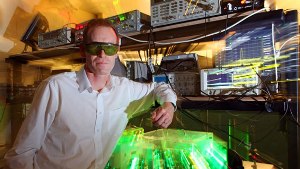Jan 9 2014
A team of Heriot-Watt scientists is developing a new kind of laser that could help astronomers to find small, ‘Earth-like’ planets outside our solar system or detect the presence of hazardous chemicals at a safe distance.
 Professor Derryk Reid
Professor Derryk Reid
The team is working as part of an international consortium that’s secured €2m to develop optical parametric oscillator (OPO) frequency comb lasers which will deliver a far greater degree of accuracy than has been previously possible.
Frequency comb laser
Known as a 'frequency comb’ laser, because its output in frequency can be thought of as a pattern of closely spaced comb teeth, the new laser operates in the infrared region of the electromagnetic spectrum which conventional frequency-comb lasers cannot, making it particularly useful for applications such as infrared gas sensing, metrology and spectroscopy.
OPO lasers offer enormous opportunities for exploitation in metrology (measurement) and broad spectrum detection, in instruments ranging from telescopes to hyperspectral imagers.
Now the Heriot-Watt team, which invented the femtosecond OPO comb technology at the core of the international Metrocomb project, will work with colleagues in other universities to explore new ways of making OPO frequency comb lasers operate in a more versatile, more reliable and user-friendly way.
Using OPOs in astronomy
One application for the new laser will be in astronomy and the hunt for planets orbiting stars outside our solar system.
While larger planets (Jupiter sized and above) can now be detected and measured quite easily with precision spectrographs, astronomers looking for smaller 'Earth-like' stars need more sensitive techniques which the new laser will facilitate.
The Heriot-Watt team has this month secured additional funding of £250,000 from the Science and Technology Facilities Council to develop frequency combs for astronomy.
Speaking about the work Professor Derryck Reid, Director of the EPSRC Centre for Doctoral Training in Applied Photonics, School of Engineering and Physical Sciences, Heriot-Watt University, said, “The new laser we are developing will offer unprecedented detection sensitivity and measurement accuracy.
“It has the potential to transform spectroscopy in the 'molecular fingerprint' region, to deliver real-time imaging with molecular identification, trace chemical detection and medical breath analysis. It also has particularly exciting applications in astronomy which we are delighted to have secured further funding to explore.”